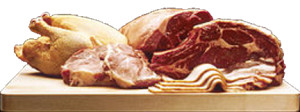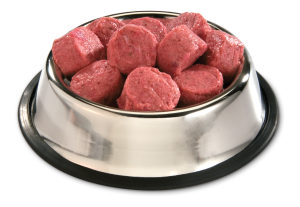Getting Started With Raw Dog Food:
Single Source or Rotating Proteins?

When faced with a choice between simple or complicated, most of us lean towards the easy choice. The good news when pondering these two raw feeding approaches is that they’re both relatively simple.
Choosing and sticking with a single food indefinitely is certainly the easier of the two. But when you look at that choice in context, there’s really not much more involved when choosing to rotate formulas. But is it worth even a small extra effort?
Raw food will offer benefits whether you feed one or many proteins
Either approach offers food in a relatively unprocessed and natural state, complete with live enzymes and truly fresh ingredients. Your dog has most likely been accustomed to eating a single food for quite some time by now. Most pet parents find a single kibble and stick with it indefinitely. You can do the same with a raw diet.
As long as you’re choosing a complete and balanced raw diet, there’s nothing wrong with sticking to a single protein source. Your dog will get the essential daily nutrients needed, and you can always add supplements as needed.
When cost is your biggest concern, stick with a chicken formula. At the moment, you’ll find that to be the most cost-effective way to feed raw. Beef and Turkey used to be priced about the same as chicken, but those costs have risen over the past few years. Fish can sometimes be a lower priced option, while Lamb and Venison get even pricier. Exotic proteins like Rabbit, Venison, Kangaroo, Pheasant and others tip the scales at the high end.
Chicken is cheapest so why look at other proteins?

The primary reason to consider an alternative to chicken will normally be a food sensitivity. Allergies and sensitivities are much less likely with a raw diet. They are still possible, but the purer, less processed form of meat and other ingredients in raw diets typically introduce fewer issues.
The majority of raw diets are grain-free, although there are some that contain grain. As raw feeding grows in popularity, expect to see more lower-end formulas that contain grain. This is not to say that formulas with grain are bad. On the contrary, one of the highest quality raw foods we recommend, Raw Advantage, uses organic grains in their Organic Chicken Dinner formula.
Another reason to introduce other, or multiple proteins for your dog is based on the nutritional makeup of different meats.
Different proteins have different amino acid profiles
You’ve most likely heard that eggs are considered the “perfect” food. This belief comes partially from the “perfect” balance of amino acids making up the proteins contained in eggs. Don’t worry- we’re not diving deeply into nutritional analysis here; just a top level glance.

Amino acids are the building blocks of all proteins. The body manufactures some amino acids and must get others from food. Each different protein, meats and eggs included, are made up of a mix of these amino acids. Eggs contain all of the essential amino acids the body cannot produce in levels that meet suggested requirements.
The levels of amino acids vary between each different protein source
Chicken is high in some amino acids, but low in others. This doesn’t mean it is deficient, although it would be if all you fed was 100% chicken. With a complete and balanced chicken-based raw food formula, those different amino acid profiles are less of a concern. Other ingredients pick up the slack and provide the proper balance.
With a complete and balanced chicken-based raw food formula, those different amino acid profiles are less of a concern. Other ingredients pick up the slack and provide the proper balance.
Since our focus is now on whole food and healthy feeding, which approach do you prefer? Supplemental ingredients to balance out your dog’s nutrition, or whole food ingredients to do the job?
Rotating protein sources offers a broader spectrum of nutrients
Multiple proteins provide a variety of amino acid profiles. To some (myself included), this offers a stronger level of nutritional support that is not found in a single source diet.
Using multiple proteins can also minimize the possibility of your dog developing sensitivities over time. Again, while this is unlikely on a raw diet, rotation is a way to give yourself some options if it does occur.
With rotation, it’s fairly easy to identify what, if any, protein source may not be well accepted. Simply remove that protein from the rotation and continue as before. Rotation also offers your dog a variety of flavor and texture, which for some is quite important.
Rotation requires an additional step but is not complicated
While not essential, we usually recommend sticking with a single manufacturer when rotating within raw food proteins. This is less of an issue if using raw as a supplement. When fed as a sole diet, rotating proteins from different manufacturers can make this approach a bit more difficult.
Each manufacturer has their own process, sources ingredients differently and uses their own methods to balance formulas. It’s less of a challenge for your dog if the primary adjustment being made is to the protein, rather than the entire diet. There will be more similarities within the formulas of a single manufacturer, which makes for easier rotation.
Now that you have the basics under your belt, the fun truly begins!

Whatever your decision, supplement or sole, small or large form, single or rotation, you’re ready to get started. If you’ve got more questions, you’re most welcome to call or email us and we’ll be happy to help you get started.
The further assist your journey, a nifty resource chart, the Raw Pet Food Comparison Chart, has been prepared for you. It should be used as a guide only, since pricing, sizes and forms are subject to change.
The Chart gives you quick reference to information from a handful of raw food manufacturers including:
- comparative prices for 3 different formulas (low to high for each brand)
- forms offered by each manufacturer
- protein source(s) offered by each manufacturer
- least expensive form of each manufacturer
The pricing in the comparison chart is presented as price per pound
This makes it simple for you to compare similar products between manufacturers without worrying about different size packages.
The numbers you see are based on retail prices (January 2015) for the least expensive form of that particular protein. For example, if a manufacturer offers a chicken formula in both nuggets and chubs, the chub pricing would used if it was lower than the nuggets pricing.
Take your time as your examine the chart. It should help answer many of your initial questions about costs and availability. As you begin to narrow down your options, you’re encouraged to visit manufacturer’s websites to learn more about their approach.
When you’re ready to move forward, we’re here to help!
Still have questions about transitioning to a raw diet? Have a look at these Frequently Asked Questions about Raw Feeding or get in touch!
